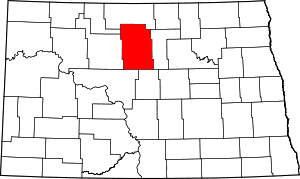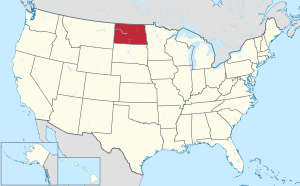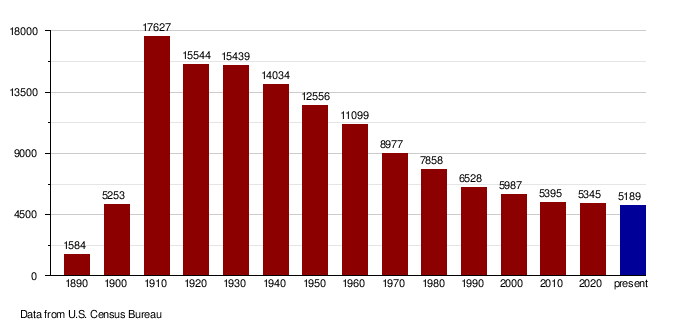County in North Dakota
| McHenry County | |
|---|---|
| County | |
 McHenry County Courthouse McHenry County Courthouse | |
 Location within the U.S. state of North Dakota Location within the U.S. state of North Dakota | |
 North Dakota's location within the U.S. North Dakota's location within the U.S. | |
| Coordinates: 48°14′N 100°38′W / 48.23°N 100.64°W / 48.23; -100.64 | |
| Country | |
| State | |
| Founded | January 4, 1873 (created) October 15, 1884 (organized) |
| Seat | Towner |
| Largest city | Velva |
| Area | |
| • Total | 1,912 sq mi (4,950 km) |
| • Land | 1,874 sq mi (4,850 km) |
| • Water | 38 sq mi (100 km) 2.0% |
| Population | |
| • Total | 5,345 |
| • Estimate | 5,189 |
| • Density | 2.8/sq mi (1.1/km) |
| Time zone | UTC−6 (Central) |
| • Summer (DST) | UTC−5 (CDT) |
| Congressional district | At-large |
| Website | www |
McHenry County is a county in the U.S. state of North Dakota. As of the 2020 census, the population was 5,345. Its county seat is Towner.
McHenry County is part of the Minot, ND Micropolitan Statistical Area.
History
The Dakota Territory legislature created the county on January 4, 1873, with territory annexed from Bottineau County. It was named for James McHenry, an early settler of Vermillion (in present South Dakota). The county government was not organized at that time, nor was the county attached to another county for administrative and judicial purposes. The county organization was effected on October 15, 1884. The county boundaries were altered in 1885, 1887, 1891, and in 1892. It has retained its present boundaries since 1892.
When the county was organized in 1884, Villard was named as county seat. In 1885 this designation was moved to Scriptown. In 1886 the designation was again moved, to Towner, which has remained the seat to the present time (the two former sites are now ghost towns).
Geography
The Souris River loops through the county before turning north to its eventual discharge into Lake Winnipeg. The Wintering River drains the southern part of the county. The county terrain consists of rolling hills, partly devoted to agriculture (including limited use of center pivot irrigation). The terrain slopes to the north and east, with its highest point on the west boundary line near the southwest corner, at 2,156 ft (657 m) ASL. The county has a total area of 1,912 square miles (4,950 km), of which 1,874 square miles (4,850 km) is land and 38 square miles (98 km) (2.0%) is water. In 2013, 131 plants were collected in the Lake George area.
Major highways
 U.S. Highway 2
U.S. Highway 2 U.S. Highway 52
U.S. Highway 52 North Dakota Highway 14
North Dakota Highway 14 North Dakota Highway 19
North Dakota Highway 19 North Dakota Highway 41
North Dakota Highway 41 North Dakota Highway 53
North Dakota Highway 53 North Dakota Highway 97
North Dakota Highway 97
Adjacent counties
- Bottineau County - north
- Pierce County - east
- Sheridan County - southeast
- McLean County - southwest
- Ward County - west
- Renville County - northwest
National protected areas
- Cottonwood Lake National Wildlife Refuge
- Denbigh Experimental Forest
- J. Clark Salyer National Wildlife Refuge (part)
- Wintering River National Wildlife Refuge
Lakes
- Bromley Lake
- Buffalo Lodge Lake
- Connia Slough
- Erickson Lake
- Heringen Lake
- Horseshoe Lake (part)
- Lake George
- Lake Hester
- Lauinger Lake
- Martin Lake
- North Lake
- Potters Lake
- Round Lake
- Smoky Lake (part)
- Stevens Slough
- Stink Lake
Demographics
| Census | Pop. | Note | %± |
|---|---|---|---|
| 1890 | 1,584 | — | |
| 1900 | 5,253 | 231.6% | |
| 1910 | 17,627 | 235.6% | |
| 1920 | 15,544 | −11.8% | |
| 1930 | 15,439 | −0.7% | |
| 1940 | 14,034 | −9.1% | |
| 1950 | 12,556 | −10.5% | |
| 1960 | 11,099 | −11.6% | |
| 1970 | 8,977 | −19.1% | |
| 1980 | 7,858 | −12.5% | |
| 1990 | 6,528 | −16.9% | |
| 2000 | 5,987 | −8.3% | |
| 2010 | 5,395 | −9.9% | |
| 2020 | 5,345 | −0.9% | |
| 2022 (est.) | 5,189 | −2.9% | |
| U.S. Decennial Census 1790-1960 1900-1990 1990-2000 2010-2020 | |||
2020 census
As of the census of 2020, there were 5,345 people.
2010 census
As of the census of 2010, there were 5,395 people, 2,377 households, and 1,527 families in the county. The population density was 2.88 people per square mile (1.11 people/km). There were 2,948 housing units at an average density of 1.57 units per square mile (0.61/km). The racial makeup of the county was 97.8% white, 0.6% American Indian, 0.3% Asian, 0.1% black or African American, 0.3% from other races, and 0.9% from two or more races. Those of Hispanic or Latino origin made up 1.5% of the population. In terms of ancestry, 55.3% were of German, 39.5% Norwegian, 5.3% English, 3.6% Swedish, 3.5% American, 2.4% Russian and 1.7% Dutch ancestry.
Of the 2,377 households, 25.3% had children under the age of 18 living with them, 53.9% were married couples living together, 5.8% had a female householder with no husband present, 35.8% were non-families, and 31.3% of all households were made up of individuals. The average household size was 2.25 and the average family size was 2.81. The median age was 46.2 years.
The median income for a household in the county was $36,944 and the median income for a family was $54,350. Males had a median income of $36,625 versus $26,205 for females. The per capita income for the county was $22,911. About 6.4% of families and 12.3% of the population were below the poverty line, including 17.1% of those under age 18 and 17.9% of those age 65 or over.
Population by decade

Communities
Cities
- Anamoose
- Balfour
- Bergen
- Deering
- Drake
- Granville
- Karlsruhe
- Kief
- Towner (county seat)
- Upham
- Velva
- Voltaire
Census-designated place
- Bantry (former city)
Unincorporated communities
- Berwick
- Cole Ford
- Denbigh
- Funston
- Genoa
- Guthrie
- Kottkethal
- Milroy
- Newport
- Norfolk
- Norwich
- Rangeley
- Riga
- Rising
- Rose Hill
- Simcoe
- Verendrye
- Willowdale
- Willow Vale
- Willow Valley
- Willow Creek
Townships
- Anamoose
- Balfour
- Bantry
- Berwick
- Bjornson
- Brown
- Cottonwood Lake
- Deep River
- Deering
- Denbigh
- Egg Creek
- Falsen
- Gilmore
- Granville
- Grilley
- Hendrickson
- Karlsruhe
- Kottke Valley
- Lake George
- Lake Hester
- Land
- Layton
- Lebanon
- Little Deep
- Meadow
- Mouse River
- Newport
- Normal
- North Prairie
- Norwich
- Odin
- Olivia
- Pratt
- Riga
- Rose Hill
- Round Lake
- Saline
- Schiller
- Spring Grove
- Strege
- Velva
- Villard
- Voltaire
- Wagar
- Willow Creek
Notable people
- Sondre Norheim, pioneer of modern skiing
- Cordell Volson, professional football player
Politics
McHenry County voters have traditionally voted Republican. In only one national election since 1936 has the county selected the Democratic Party candidate.
| Year | Republican | Democratic | Third party(ies) | |||
|---|---|---|---|---|---|---|
| No. | % | No. | % | No. | % | |
| 2024 | 2,223 | 80.78% | 479 | 17.41% | 50 | 1.82% |
| 2020 | 2,364 | 78.72% | 564 | 18.78% | 75 | 2.50% |
| 2016 | 2,050 | 72.70% | 490 | 17.38% | 280 | 9.93% |
| 2012 | 1,678 | 61.87% | 943 | 34.77% | 91 | 3.36% |
| 2008 | 1,374 | 56.87% | 981 | 40.60% | 61 | 2.52% |
| 2004 | 1,744 | 61.84% | 1,030 | 36.52% | 46 | 1.63% |
| 2000 | 1,682 | 61.45% | 888 | 32.44% | 167 | 6.10% |
| 1996 | 1,187 | 43.07% | 1,096 | 39.77% | 473 | 17.16% |
| 1992 | 1,321 | 38.90% | 1,173 | 34.54% | 902 | 26.56% |
| 1988 | 1,888 | 52.69% | 1,665 | 46.47% | 30 | 0.84% |
| 1984 | 2,485 | 65.38% | 1,283 | 33.75% | 33 | 0.87% |
| 1980 | 2,922 | 71.20% | 939 | 22.88% | 243 | 5.92% |
| 1976 | 2,043 | 49.70% | 1,994 | 48.50% | 74 | 1.80% |
| 1972 | 2,765 | 63.62% | 1,554 | 35.76% | 27 | 0.62% |
| 1968 | 2,226 | 54.21% | 1,595 | 38.85% | 285 | 6.94% |
| 1964 | 1,728 | 39.46% | 2,643 | 60.36% | 8 | 0.18% |
| 1960 | 2,715 | 54.87% | 2,231 | 45.09% | 2 | 0.04% |
| 1956 | 3,019 | 62.12% | 1,825 | 37.55% | 16 | 0.33% |
| 1952 | 4,227 | 76.60% | 1,228 | 22.25% | 63 | 1.14% |
| 1948 | 2,578 | 56.45% | 1,770 | 38.76% | 219 | 4.80% |
| 1944 | 3,141 | 61.44% | 1,934 | 37.83% | 37 | 0.72% |
| 1940 | 3,894 | 63.07% | 2,225 | 36.04% | 55 | 0.89% |
| 1936 | 1,619 | 26.24% | 3,294 | 53.40% | 1,256 | 20.36% |
| 1932 | 1,396 | 25.08% | 3,937 | 70.73% | 233 | 4.19% |
| 1928 | 2,914 | 53.04% | 2,535 | 46.14% | 45 | 0.82% |
| 1924 | 1,692 | 36.89% | 264 | 5.76% | 2,631 | 57.36% |
| 1920 | 3,534 | 74.09% | 848 | 17.78% | 388 | 8.13% |
| 1916 | 692 | 31.33% | 1,316 | 59.57% | 201 | 9.10% |
| 1912 | 589 | 23.61% | 959 | 38.44% | 947 | 37.96% |
| 1908 | 1,772 | 56.16% | 1,296 | 41.08% | 87 | 2.76% |
| 1904 | 1,807 | 73.54% | 556 | 22.63% | 94 | 3.83% |
| 1900 | 595 | 70.00% | 222 | 26.12% | 33 | 3.88% |
See also
References
- ^ "State & County QuickFacts". United States Census Bureau. Retrieved April 4, 2023.
- "Find a County". National Association of Counties. Archived from the original on May 31, 2011. Retrieved June 7, 2011.
- "Dakota Territory, South Dakota, and North Dakota: Individual County Chronologies". Dakota Territory Atlas of Historical County Boundaries. The Newberry Library. 2006. Archived from the original on April 2, 2018. Retrieved February 3, 2015.
- "County History". Official Portal for North Dakota State Government. Archived from the original on February 2, 2015. Retrieved May 4, 2011.
- ^ "McHenry County · North Dakota". Google Maps. Retrieved April 27, 2024.
- ""Find an Altitude/McHenry County ND" Google Maps (accessed February 23, 2019)". Archived from the original on May 21, 2019. Retrieved February 24, 2019.
- "2010 Census Gazetteer Files". United States Census Bureau. August 22, 2012. Archived from the original on January 29, 2015. Retrieved February 1, 2015.
- The checklist of the flora of Lake George environs, McHenry County, North Dakota
- "Annual Estimates of the Resident Population for Counties: April 1, 2020 to July 1, 2022". Retrieved April 4, 2023.
- "U.S. Decennial Census". United States Census Bureau. Retrieved February 1, 2015.
- "Historical Census Browser". University of Virginia Library. Retrieved February 1, 2015.
- Forstall, Richard L., ed. (April 20, 1995). "Population of Counties by Decennial Census: 1900 to 1990". United States Census Bureau. Retrieved February 1, 2015.
- "Census 2000 PHC-T-4. Ranking Tables for Counties: 1990 and 2000" (PDF). United States Census Bureau. April 2, 2001. Retrieved February 1, 2015.
- ^ Genealogy Trails: North Dakota (accessed February 23, 2019)
- Leip, David. "Atlas of US Presidential Elections". uselectionatlas.org. Retrieved April 12, 2018.
External links
- McHenry County JDA
- McHenry County maps, Sheet 1 (northern) and Sheet 2 (southern), North Dakota DOT
| Places adjacent to McHenry County, North Dakota | ||||||||||||||||
|---|---|---|---|---|---|---|---|---|---|---|---|---|---|---|---|---|
| ||||||||||||||||
| Municipalities and communities of McHenry County, North Dakota, United States | ||
|---|---|---|
| County seat: Towner | ||
| Cities |  | |
| Townships |
| |
| Unorganized territory | ||
| Other communities | ||
| Indian reservation | ||
| Footnotes | ‡This populated place also has portions in an adjacent county or counties | |
48°14′N 100°38′W / 48.23°N 100.64°W / 48.23; -100.64
Categories: